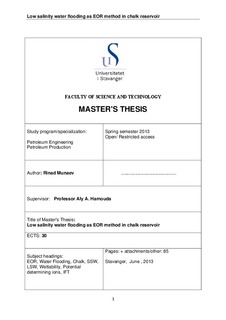| dc.description.abstract | During the last few years studies of the low salinity water flooding effect, in general, have
demonstrated an additional oil recovery associated with flooding oil reservoirs with low
salinity water. Numerous theories have been suggested as explanation for the mechanism of
the incremental oil recovery; however they are debatable.
Those theories are based on researches performed using wide variations of porous media and
types of oils and experimental conditions. This is perhaps the reason that it is still debatable.
Furthermore almost certainly, low salinity water flooding is an effect of various mechanisms
acting together.
To perform the first laboratory experiments, initially the four cores from Obourg out crop
chalk from Belgium were established for initial water saturation (Swi) using synthetic sea
water (SSW) by flooding of n-Decane + stearic acid, 0.005 mole/l, aged for two weeks at 50
ºC and then flooded for oil production at 70 ºC.
The experimental scheme that was followed here is by flooding chalk cores first with
seawater (SSW), followed by low salinity water (LSW) or single ion water such as SO4
2- or
Mg2+. To address the change of the surface of the flooded cores, the cores were re-saturated
with modified oil (n-C10) with stearic acid (SA), representing a one of the natural surfactant
in the oil, and aged for 2weeks before running the imbibition experiments. The imbibing
fluids were SSW followed by LSW or SO4
2- or Mg2+.
The used chalk cores are Stevns Klint outcrop chalk (SK) from Denmark. These type of cores
showed to be persistent to chemical reaction with the modified oil (n-C10 and SA). This
enabled us to carry out the planned work.
An additional oil recovery of about 1 % from secondary flooding (after SSW) of SK cores
with LSW and Mg2+ was obtained. The imbibition experiments with LSW and Mg2+ after the
re-saturation, aging and use of SSW as first imbibing fluid, showed estimated recovery of
1.3% (≈1%) and 1.6%, for LSW and Mg2+, respectively. In the case secondary flooding with
SO4
2- , no additional recovery was observed, however in the imbibition experiments as a
second imbibing fluid (after SSW), an additional recovery of approximately 1% was obtained.
It is observed in the flooding experiments with low salinity water, that the pressure drop
across the core was reduced by about 2 bar (from 3.2 to 1.2). It was also noted in both
flooding and imbibition presence of fines and a third phase, which is suspected to be an
emulsion phase. This may suggest wettability change with fine migration and effective
sweep/contacted oils during flooding and imbibition. | no_NO |
